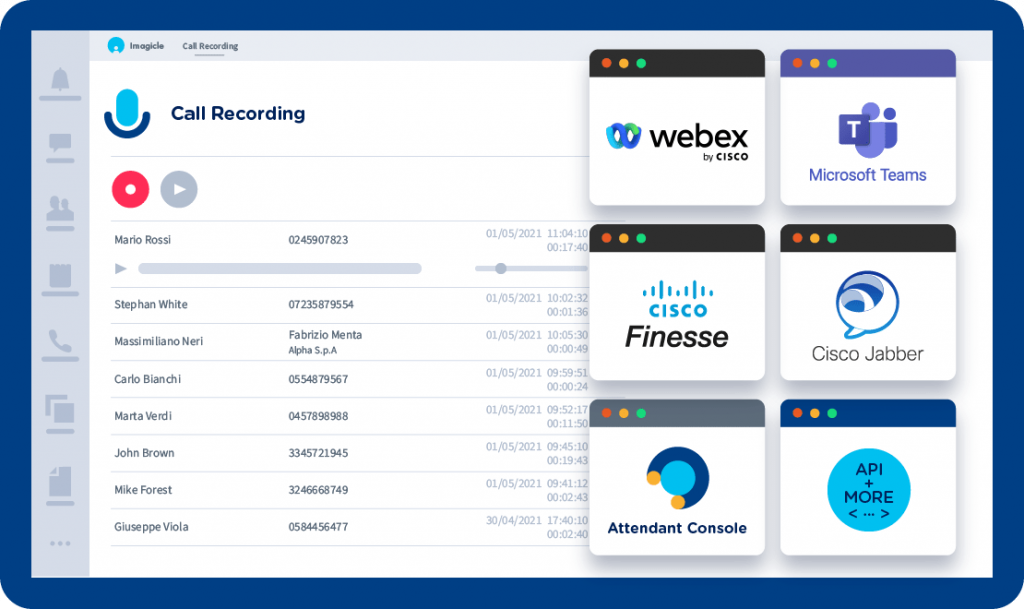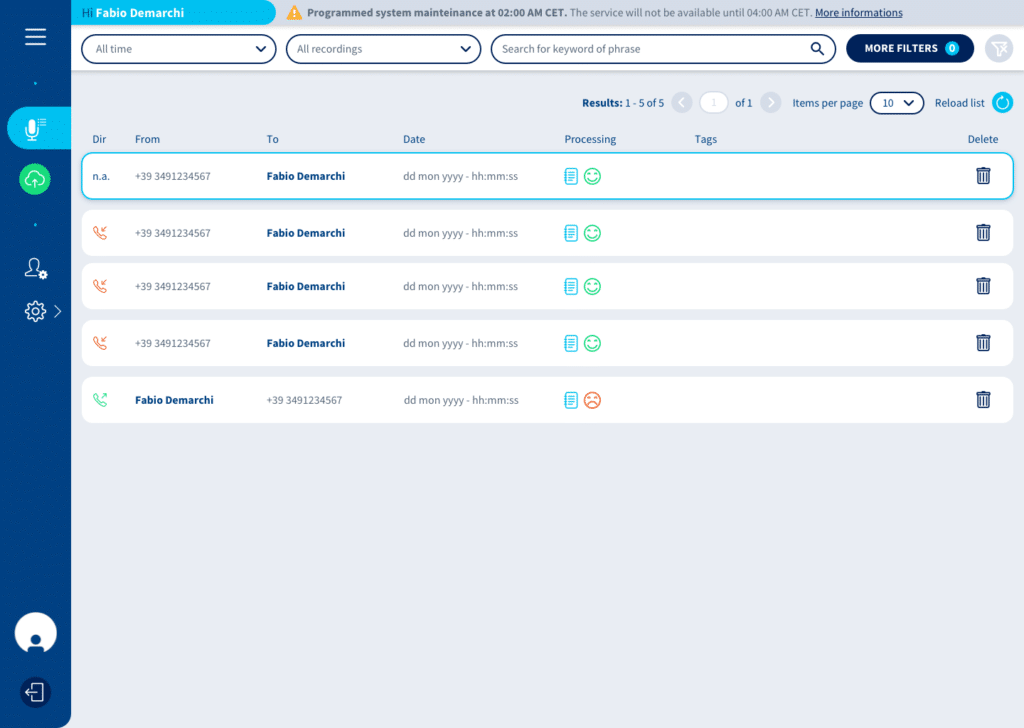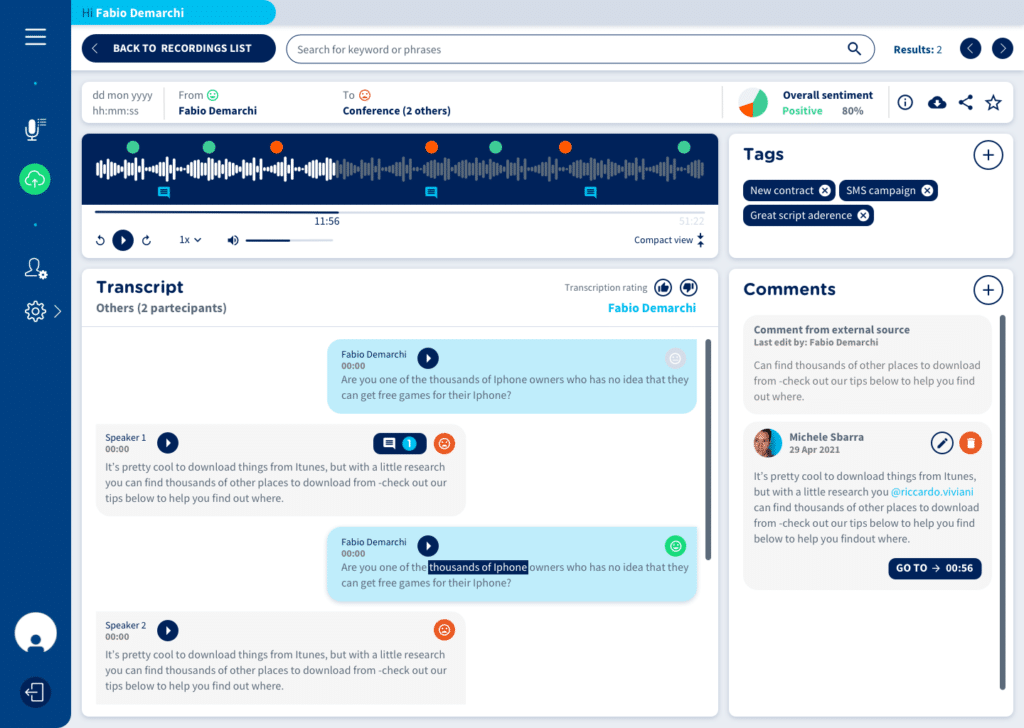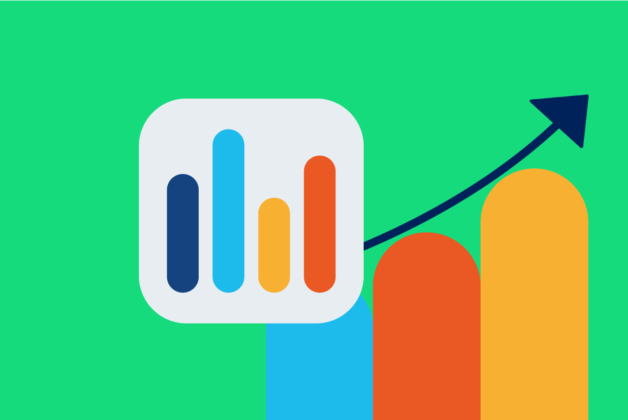 Marco Cerri - 20 Ottobre, 2021 - 7 ’ read
Marco Cerri - 20 Ottobre, 2021 - 7 ’ readVoice Analytics: AI and use cases to elevate customer satisfaction.
Authors

Marco Cerri
R&D Manager Product Owner

Fabio Demarchi
UX/UI Designer
Conversation Analysis: addressing new needs.
Business needs to stay secure, flexible, and compliant with regulations such as MiFID II and PCI-DSS have caused a growing demand for call recording solutions. That’s why we created Imagicle Call Recording a few years back, along with the goal of improving customer success.

But recording more and more phone conversations results in a new problem. You can potentially have a huge amount of words spoken in your memory storage, but a very short time to listen to them all. If you want to spot potential issues or improvements in your support team, customer care team, or sales team, you should probably travel back and forward through time to be able to listen to every conversation!
In a few words, while recording features remain fundamental, having a tool to analyze conversations and obtain speech analytics insights quickly becomes increasingly significant. The main reason surely is quality assessment, but security and compliance are barely the second.
Wanna see our Voice Analytics in action?
Register for the dedicated webinar and enjoy a live demo.
Wednesday, January 26, 11,30 AM
Artificial Intelligence might be the right key.
In a market that’s always hungry to bring the customer at the center of its decisions, it is indisputable that emerging technologies can foster the natural evolution of communication systems. Many companies have, in fact, invested in Quality Management tools, to help supervisors manually listen to some conversations (usually less than 5%) and add specific data or tags for statistic evaluations.
Artificial Intelligence is fundamental to make up for the lack of time for analyzing conversations. As Forrester says in this article, AI has given a jolt to speech analytics technologies, as it has the potential to improve transcription accuracy and simplify their analysis to measure “tone, sentiment, and emotion of the speakers”, unraveling new insights that we didn’t know about.
That’s what inspired us in creating our new Imagicle Voice Analytics application. Leveraging on AI, in particular on speech-to-text and sentiment analysis, we wanted to create a really useful tool that helps you save time and have real insight into every conversation you are recording.
This opens new avenues to making your customers happy, which, after all, is the Imagicle motto.
Our new Imagicle Voice Analytics is a cloud-native application, crafted for small to large companies. It allows you to enhance your Imagicle Call Recording by bringing it to its maximum potential in a number of different scenarios.
But without further ado, let’s understand what Voice Analytics really is.

What is Imagicle Voice Analytics in detail?
In short, Imagicle Voice Analytics is a tool that provides you with speech-to-text transcriptions of your voice calls. This data can be used to better understand your customers’ needs, identify new marketing opportunities, or evaluate the performance of call center agents. After the data is transcribed, a business can use the output to quickly identify key phrases.
If you’d like to see it in action right away, watch the dedicated webinar, complete with a live demo.
And if you have further questions, contact us after!
Some indisputable advantages of such a system are:
- The possibility to analyze all the recordings on time without ever losing any detail or point of interest, which with current systems would only be possible by listening to all the recordings;
- Save time and money in the analysis phase;
- The ability to act proactively and precisely in case of need, whether we are talking about the training of operators, or about intercepting problems with a customer. In this scenario, it means being able to act in such a way as to transform the customer from dissatisfied to enthusiastic.
In addition to this, using a sophisticated and market-leading AI engine, we added the magic of Sentiment Analysis, an analysis that will automatically communicate the mood of both parties throughout the phone call. A feature that will change the way to analyze and approach a recording, but even better, it will let your company fully express its potential. How? By allowing you to act faster on customer issues so that from now on, there are no more dissatisfied customers left to fend for themselves.
All this, from today, is no longer just a goal, but a reality thanks to our cloud-native application to meet the needs of increasingly versatile and accessible systems everywhere.

How does sentiment analysis work?
The sentiment analysis included in Voice Analytics basically translates into a set of describing words attached next to the transcriptions, giving you the opportunity to understand at a glance how the call went.
Following the UX design principle that in many cases “less is more”, we decided to describe the sentiment of the calls with essentially three easy and well identifiable words: Positive, Neutral, and Negative. An easy and powerful main indication that helps the supervisor to focus on what they need to discover.
After that, the sentiment indicator is further divided into Overall, Speaker, and Single Phrase levels, increasingly adding layers of detail to a single conversation if and when requested.
- The Overall Sentiment is an average calculation on the entire conversation mood and its purpose is to highlight calls that contain a possible bad situation to investigate. In fact, this type of sentiment indication is also present in the main recording list, to give you the possibility to find at a glance conversations that need attention.
- The Speaker Sentiment indication analyzes the average sentiment of the single speaker, giving the possibility to rapidly understand, for example, if the customer was angry while the agent wasn’t.
- The Single Phrase Sentiment is the most detailed of the three, useful to locate the “hot” part of the conversation.

A touch of User eXperience added to the recipe.
The end-user is always at the center of our attention because they are the one who will use our products every day, trying to make the most of their potential to achieve their goals.
For this, it is necessary to structure a clear plan right away, with the right mix of technology and human-centered design.
In Imagicle, we approach each process giving a lot of weight to the analysis of user personas, user journey, and graphic design, thus arriving at the end with a defined, functional, and beautiful product.
The secret lies precisely in the first phase, that of the analysis. This is where the foundations are laid. Thanks to the in-depth research and the obsessiveness that we put into the study of every detail and data at our disposal, we can reach the hearts of our customers.
A structured process is essential. It needs to be created and carried out with many years of experience behind it, and if the total weight is given to the Customer Experience, you will find the recipe for building great products.
Let’s deep dive in the most common Voice Analytics use cases.
Improve Training & Customer experience.
Call transcription and Sentiment Analysis can be used by call centers and businesses to assist operators with training. Extracting keywords from the text and creating a density map of them can help understand what keywords are successful (or not) at closing deals.
Moreover, focusing on calls with negative sentiment can be a very fast way to identify conversations where the customer is dissatisfied, learn how you can improve their experience in the future, and adapt the operator training as well.
Share information.
In most businesses, there is often a chain of communication whereby information is disseminated from one area of the business to another.
Take for example a traditional sales team that closes a sale but is then tasked with explaining the customers’ detailed requirements to their technical colleagues. More often than not, the handover takes time, is incomplete, or key details have been captured inaccurately.
By recording and transcribing calls, your team will not only be able to share their conversations efficiently but have a written note of the customers’ requirements – coming directly from the customer, with no mediators – to refer to.
In this particular scenario, even the possibility to tag and write offline notes is very useful to share important information among teams.
The importance of identifying who is speaking.
Regarding the speech-to-text service, one important thing that many softwares are not able to accomplish is the correct identification of who’s speaking in every moment of the conversation.
The AI engines are usually able to distinguish speakers in the phone conversation (with a variable error rate due to the similarity of some voice tones) but they can only label them as “Speaker 1” and “Speaker 2”. The recording software knows that the call has been made between the agent John Doe and the customer, the company Acme (for example), but it’s not so easy to say if John is the Speaker1 or the Speaker2 in the transcription! This association is very important for example to search for calls with the customer that have a negative sentiment and investigate the reason.
This correct association can be reached with a good building of the recording engine in regards to the protocols of each calling system and the correct use of AI.
The key point is to separate voices at the source and produce audio files with channels dedicated to each speaker. That’s fundamental to understand which audio channel belongs to John’s voice before the transcription process starts.
We did that by combining an optimization in the Imagicle Call Recording software with correct audio processing in the Voice Analytics AI engine, but enough technicalities. 🙂
Conclusions.
As Imagicle, our goal is to make customers happy through technology that simplifies and improves their lives and sets them up for success. Imagicle Voice Analytics adds a layer of professionalism and attention to detail to your Call Recording, allowing you to close more deals, support cases, orders, and any other thing you need with a smile from your operators and your customers.
Generally available before the end of the year, Imagicle Voice Analytics will be sold along with your Call Recording license with an additional subscription. Although it will be available only as a Cloud service, it can be connected to On-Prem Call Recording as well. For more information about pricing, you can visit the dedicated page.
Are you ready to unlock the true power of your phone conversations? 😉
New Voice Analytics: insights for better customer service.
You’ve learned about Voice Analytics, now it’s time to see it in action.
Watch the webinar to enjoy a free, live demo.
Potrebbe interessarti anche...
-
Products BlogCloud or Dedicated Cloud. What’s best?You're migrating to the Cloud and you need to choose between a public or private instance? This article will help you.
-
Release BlogWebex Single Sign-On for Imagicle apps. Simplified access, increased security.With Spring '22, all Imagicle apps will be accessible through Webex's Single Sign-On. Find out how this make your life easier.
-
Products BlogImagicle Attendant Console for Webex Calling: the operator console that was missing.Discover a new native integration. Attendant Console is fully compatible with all Cisco platforms!







